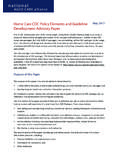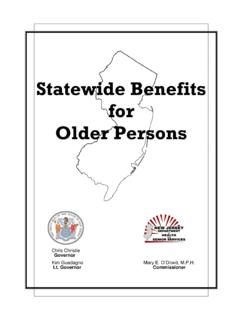Transcription of NATIONAL AGED CARE ALLIANCE - naca.asn.au
1 NATIONAL aged care ALLIANCE AUGUST 2017. NATIONAL aged care ALLIANCE . Submission in response to the Department of Health discussion paper July 2017. Future reform an integrated care at home program to support older Australians About the NATIONAL aged care ALLIANCE The NATIONAL aged care ALLIANCE (the ALLIANCE ) is a representative body of peak NATIONAL organisations in aged care , including consumer groups, providers, unions and health professionals, working together to determine a more positive future for aged care in Australia. Further information about the ALLIANCE is available at CONTENTS. aged care ALLIANCE Background 3. Reform Context 4. Reforms to date 4. What type of care at home program do we want in the future?
2 5. NATIONAL Policy objectives 5. Support@Home Program Design Principles 5. Reform options 8. An integrated assessment model 8. New higher level home care package Changing the current mix of home care packages 11. Changing the current mix of individualised and block funding 11. Refocussing assessment and referral for services 15. Ensuring that services are responsive to consumer needs and maximise independence 15. Accessing services under different programs 17. Supporting specific population groups 17. Supporting informed choice for consumers who may require additional support 18. Other suggestions for reform 19. Major structural reform 20. What would be needed to give effect to these structural reforms?
3 20. Broader aged care reform 23. Informal carers 23. Technology and innovation 23. Rural and Remote areas 24. Regulation 26. aged care and health systems 27. Any further comments? 29. 2 NACA SUBMISSION TO THE DEPARTMENT OF HEALTH DISCUSSION PAPER. AUGUST 2017. Background NATIONAL The NATIONAL aged care ALLIANCE (the ALLIANCE ) is a representative body of peak NATIONAL organisations in aged care , including consumer groups, providers, unions and health professionals, working aged care ALLIANCE together to determine a more positive future for aged care in Australia. The ALLIANCE welcomes the opportunity to respond to the Department of Health's (the Department) discussion paper Future reform an integrated care at home program to support older Australians.
4 The ALLIANCE considers that the creation of a single integrated home care program is a key step in achieving the recommendation of the Productivity Commission's Caring for Older Australians Report that supports a single integrated, and flexible system of care entitlements' and to deliver on the ALLIANCE 's vision for ageing that: Every older Australian is able to live well with dignity and independence in a place of their choosing with a choice of appropriate and affordable support and care services as and when they need them . The ALLIANCE has developed a discussion paper, Increasing Choice Stage 2: Integrating Home care Packages and the Commonwealth Home Support Program (CHSP), 31 May 2017. The discussion paper addresses Commonwealth 2017 Budget announcements relating to aged care and outlines the ALLIANCE 's views on what is required to ensure an appropriate transition for consumers and providers to a single home care program and the key milestones to be achieved between now and 2020.
5 For the purposes of the ALLIANCE 's discussion paper, the new program formed by the integration of the Commonwealth Home Support Program (CHSP) and Home care Packages (HCP) is referred to as This is not a suggested name, rather a working title. The Support@Home name is used within this submission in the same way care at home is used in the Department's discussion paper. FUTURE REFORM AN INTEGRATED care AT HOME PROGRAM TO SUPPORT OLDER AUSTRALIANS 3. JUNE 2017. Reform Context Reforms to date aged care ALLIANCE For more than a decade, the ALLIANCE has been at the centre of improvements in aged care . The ALLIANCE has welcomed and embraced the opportunity to work collaboratively with Government on the design and implementation of the reforms to date.
6 In recognising the breadth, depth and pace of the reforms the ALLIANCE strongly supports the intensified effort required to continue the momentum of reform. NATIONAL There is still much work to do to achieve quality aged care services that are consumer driven, have a focus on wellness and reablement, are affordable for the community and individuals, are sustainably provided and are inclusive of the diversity of older people. Older people who may face additional barriers to accessing aged care , such as the special needs groups recognised in the aged care Act 1997, must be considered at every stage of the reforms or they are at risk of being left behind. Those who may need additional support include, but are not limited to: People living with cognitive impairment and dementia.
7 People who require palliative and end-of-life care ;. People experiencing disability;. People of Aboriginal and Torres Strait Islander communities;. People from culturally and linguistically diverse backgrounds;. People in rural or remote areas;. People experiencing financial or social disadvantage;. Veterans;. People who are homeless or at risk of becoming homeless;. care Leavers;. Parents separated from their children by forced adoption or removal; and People of diverse sexual orientation, gender identity or intersex characteristics (LGBTI). Increasing the momentum of the reform process requires government and industry action. Whilst early planning and co-design are essential for the next steps in the process of reform, the need to see action is also essential.
8 The ALLIANCE strongly supports the establishment of an Advisory Group with representation from consumers, providers, professionals, unions and government to support and assist in the co-design of the next stages of the reforms. The ALLIANCE is keen to work collaboratively with Government to establish this group. The ALLIANCE acknowledges the impact of the whole of the reform process on the sector to date. Consumers and providers have been impacted through earlier areas of the reforms where there were limited consultations, short timeframes for implementation, or insufficient mitigation of known issues ( equity of access in rural and remote areas). Currently service providers are still adjusting to the new Home care Packages marketplace and the ACFI reforms, and are seeking clarification on the sequencing of changes between now and 1 July 2020 ahead of full integration of CHSP and HCP.
9 4 NACA SUBMISSION TO THE DEPARTMENT OF HEALTH DISCUSSION PAPER. AUGUST 2017. What type of care at home program do we want in the future? Policy objectives NATIONAL Program Architecture aged care ALLIANCE The ALLIANCE reaffirms its support for the Government's intention to create a single integrated care at home program and acknowledges the policy objectives outlined on page 9 of the discussion paper and reinforces the following broad policy objectives identified by members: To make the system easier to navigate for consumers To increase choice and control for consumers in relation to their care To ensure that the system is sustainable into the future To simplify funding arrangements and reduce red tape for providers To deliver a system that results in equitable consumer contributions based on individuals'.
10 Capacity to pay and the level of care and support being received Furthermore, the ALLIANCE supports the integration of HCP and the CHSP as the first step in achieving the vision outlined in the aged care Roadmap of a single aged care system in which unnecessary distinctions between home care and residential care are removed. The ALLIANCE recognises that these changes represent an important philosophical shift in the way aged care services are delivered in the community, and the relationships between Government, service providers and consumers. The impact of this is an opportunity to not only create a new program that will serve the longer term needs of Australia's ageing population, but also as an opportunity to promote positive societal attitudes about ageing and aged care and encourage individuals and families to proactively plan and prepare for their future care needs and promote wellness and reablement.




